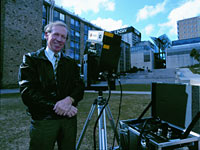|
|||||||||||||||||||||||||||||||||||||||||
| Surveying & Spatial Info Sys - 3741 | |||||||||||||||||||||||||||||||||||||||||

The BE in Surveying and SIS is a four year, full time degree program. This program aims to prepare a graduate for a broad range of career opportunities in the various branches of Surveying and the numerous Spatial Information disciplines. To this end the program covers general scientific and IT principles, as well as specialised Surveying and Spatial Information topics. Specialisation is provided for through the provision of elective courses offered in the third and fourth years of the program and the choice of a targeted final year thesis project often aligned with an external industry partner.
The degree of BE in Surveying and SIS is recognised by the Board of Surveying and Spatial Information of New South Wales as meeting the requirements for entry as a candidate to become a Registered Surveyor. The degree is also recognised by the Institution of Surveyors, New South Wales, the Spatial Sciences Institute and Engineers Australia, for admission as corporate members. Note: Surveying and Spatial Information Systems is also available as a component of the combined degree programs BE (SSIS)/BSc program 3746,program 3746 BE (SSIS)/BA, program 3747,program 3747 BE(SSIS)/BCom, program 3715,program 3715 For details of all academic requirements for this program, see http:www.eng.unsw.edu.au/rules/ Program Objectives and Learning Outcomes Please see http:www.eng.unsw.edu.au/rules/
The program structure below gives one sequence of courses that fulfils the requirements of the degree. The timing of the general education courses and elective courses may be modified to optimize the student's choice of courses. Suggestions for other course sequences consistent with timetabling and availability can be found on the School website at http://www.gmat.unsw.edu.au While some courses are given twice a year, many courses are given only once a year. In addition, courses may have prerequisites and exclusions. Thus students should plan their enrolments appropriately.
PLEASE NOTE
Year 1 (Flexible)
Choose ONE of:
And ONE of:
And ONE of:
Plus these following 3 courses:
Plus choose two electives from the Year 1 Elective list
http://www.eng.unsw.edu.au/rules/elective.htm Suggested Year 1 elective for this program is:
Year 2
Year 3
Year 4
Year 3 Electives
Suggested (others may be accepted with head of School approval) CVEN0610 Water and Soil Engineering COMP1911 Computing 1 COMP1921 Data Structures and Algorithms Year 4 Electives GMAT 4400 Land Management and Development Design 1 (6UOC 2hpw) GMAT4860 Sustainable Land Development (6UOC 5hpw) GMAT4900 Principles of GNSS Positioning (6UOC 3hpw) GMAT4450 Land Management and Development Design 2 (6UOC 2hpw) GMAT4910 Modern Navigation and Positioning Technologies (6UOC 3hpw) GMAT9211 Introduction to Geodesy GEOH3911 Environmental Impact Assessment MINE3410 Metal Mining Systems MINE3420 Coal Mining Systems and other electives with the approval of the Head of School. Total HPW Session 1 and 2 depends on electives chosen. Area(s) of Specilisation
PROGRAM STRUCTURE FOR STUDENTS WHO COMMENCED PRIOR TO 2006 IS AS FOLLOWS:
Electives
Any remaining Year 3 electives
and
The following electives 5 HPW, 6UOC courses may be chosen once COMP1911, COMP1921 and MATH1081 have been completed:
and other electives with the approval of the Head of School.
The School has available a list of suggested subject selections for course streams in Cadastral Surveying and Land Development as well as GPS and Geographic Information Systems. Please contact the School Office. Total HPW Session 1 & 2 depends on electives chosen Total Units of Credit 48 General Education Requirements Please see http:www.eng.unsw.edu.au/rules/
Please see http:www.eng.unsw.edu.au/rules/
Please seehttp:www.eng.unsw.edu.au/rules/
For information regarding fees for UNSW programs, please refer to the following website: https://my.unsw.edu.au/student/fees/FeesMainPage.html
Industrial Experience Requirements Please seehttp:www.eng.unsw.edu.au/rules/
Students may have to complete a number of field projects as part of their program and are expected to complete all necessary fieldwork for any course. They must be prepared to pay all the appropriate costs associated with these field projects, and must be in attendance at all scheduled examinations, except in exceptional circumstances.
The degree of BE in Surveying and Spatial Information Systems is recognised by the Board of Surveying and Spatial Information of New South Wales as meeting requirements for entry as a candidate to become a Registered Surveyor in New South Wales. The degree is recognised by the Institution of Surveyors, New South Wales, the Spatial Sciences Institute, and the Institution of Engineers Australia (IEAust.) for admission as corporate members.
Students wishing to become Registered Surveyors after graduation are advised to gain practical experience under a Registered Surveyor during their program. Details are obtainable from the Registrar, Board of Surveying and Spatial Information of NSW, P.O. Box 143, Bathurst NSW 2795. Area(s) of Specialisation |
|||||||||||||||||||||||||||||||||||||||||


